Scam Awareness or Fraud Awareness

Helping you be safe from frauds and scams
We're always looking out for our customers and their wellbeing. This page can help you steer clear from a variety of frauds and scams out there. We've even included contact information if you'd like to notify us of a scam using our name and/or logo, or to file a report with a government agency.
FAQ
- Safety Tips
- Be suspicious of unsolicited emails, phone calls, or text messages asking for personal or financial information.
- Never respond to emails or texts from someone you don't know or whose identity you can't confirm.
- Never provide personal or financial information unless you are certain of the identity of the person or business that is contacting you.
- Never open suspicious attachments or links.
- Never purchase something that was advertised in an unsolicited email.
- Never send money or other type of monetary payment to someone you don't know.
- If you are contacted by someone you don't know, conduct online research. You can search a phrase that describes the situation or look up the email or phone number that contacted you.
- If you're unsure if a phone call or email is really from the company it claims to be, call the number from their legitimate website. Do not call the number that initially called you or one provided in the email.
- Look closely at the sender's email address and embedded URL's. More sophisticated scammers will create fake domains and websites that look nearly identical to the legitimate business.
- Hover your mouse over a link to see the embedded URL. Do not click on the link if the address is different than the display text.
- Do not deposit a check that is sent to you with instructions to wire money back to the sender or a 3rd party. Banks are required by law to make deposited check funds available within days and identifying a fake check can take several weeks. If a check you deposit turns out to be fraudulent, you will be responsible for paying the bank back.
- Regularly monitor your financial statements to detect any fraudulent charges. If an unauthorized charge is made to your account, immediately contact your bank or account provider.
- Gift Card & Money Transfer Scams
There are a few different scams of this variety to be aware of:
Emergency Scam
The scammer calls pretending to represent a loved one in an emergency that requires payment with gift cards or a money transfer. Bail payment, medical expenses, or emergency travel funds are common scenarios used in these schemes. Scammers often target the elderly in these situations, typically impersonating a grandchild or person of authority (e.g., law enforcement, medical professional, attorney).
IRS Scam
The scammer impersonates an IRS employee and threatens legal action or imprisonment if they don't receive payment by money transfer or gift cards for unpaid taxes.
Online Seller Scam
Often taking place on a resale site or online marketplace (e.g., Craigslist, OfferUp), the scammer advertises an item for a price that seems too good to be true and requests payment in the form of gift cards or a money transfer. Once the payment is received, they cut off all means of communication with the victim.
If you’ve been scammed into paying with gift cards purchased at a Walgreens store, please contact us at 1-877-865-9130. Be prepared to provide a copy of your purchase receipt and images of the front and back of the card(s).
We will work with our gift card processor and the 3rd party gift card issuer to attempt to recover any available funds on the cards. Please note that if the account numbers and PINs have been disclosed to the scammer and the balance has been depleted, we will not be able to return any funds back to you. Due to the high volume of reports, the process can take up to twelve weeks to resolve.
Tips to Avoid Gift Card & Money Transfer Payment Scams
- Consider the type of payment being requested. Since credit cards have fraud protection, many social engineers ask for payment through a money transfer or a gift card because it's nearly impossible to get your money back. Reputable companies and government organizations won't request to be paid this way.
- Pay individual sellers for online orders through an official selling platform (e.g., Etsy) or a payment service like PayPal. These websites typically offer order protection and will issue a refund if a purchase isn’t received, or an order isn’t as described.
- Be aware that a fraudster may use social media to find the names of a potential victim's friends and family to make their story seem more convincing.
- Discuss the situation with someone before reacting. Scammers create a sense of urgency and may even make threats to rush you to make decisions. Slow down and reflect on their story, conduct some research, or talk it through with a friend.
- Phishing Emails
Phishing emails attempt to entice you to click on a link that will take you to a fraudulent website that may seem legitimate. The site may ask you to "login" with your user ID and password so the scammer can then use your login credentials to take over your real account. You may also be asked to input personal or financial information that could expose you to future compromises, financial losses, and/or identity theft. The website could also contain malicious code or the email itself may have an attachment that installs malware on your device.
As with caller ID spoofing, phishing emails may use Walgreens’ name and/or logo to make it appear more legitimate. However, emails officially from Walgreens will only come from the following domains: @walgreens.com, @eml.walgreens.com, @rxorder.walgreens.com, @ecs.walgreens.com, or @e.walgreens.com. Most emails from Walgreens regarding myWalgreens, Photo, Vision, and Walgreens.com will come from the email address Walgreens@eml.walgreens.com. The example below shows the sender’s email address is one not authentically belonging to Walgreens.

Walgreens will never send you emails asking for your credit card number, social security number, or other personally identifiable information for any reason. If you are ever asked for this information, you can be confident it is not from Walgreens.
Phishing Email Red Flags
- The domain of the sender's email address does not include the name of the business it's impersonating or it varies from the company's legitimate domain.
- The name of the company is in the username portion of the sender's email address.
- The embedded URL of a link doesn't match its display text in the email.
- It claims you won a contest when you didn't enter one or are approved for something you didn't apply for.
- An unknown email address is cc'd on the email.
- The email offers a free gift but requires payment for a fee, taxes, or shipping charges.
- It contains an impersonal salutation such as "Dear Shopper" or "Greetings".
- The email conveys a strong sense of urgency that is intended to make you ignore red flags.
- It has spelling errors or poor grammar.
- The email contains an attachment that the message urges you to open.
Examples of Phishing Emails Impersonating Walgreens
Free Gift Card or Prize
These emails claim they are offering a free gift as part of a giveaway. Walgreens does not offer these types of promotions and we do not contact our customers through unsolicited email campaigns.
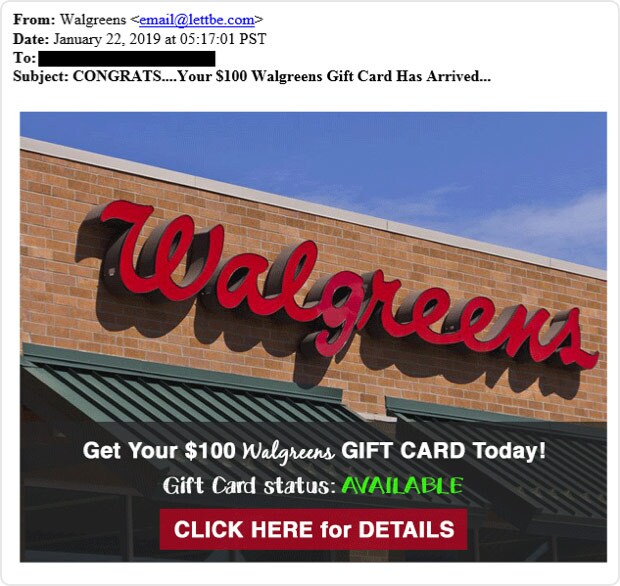
Reward for Completing a Survey
Customer survey requests that are legitimately from Walgreens are offered at the bottom of an in-store purchase receipt or sent from the email address Walgreens@eml.walgreens.com to customers who recently placed an order on Walgreens.com. If you receive a survey request via email that states it’s from Walgreens and you didn’t recently make an online purchase or it offers anything in return for participating in the survey, you should delete it.
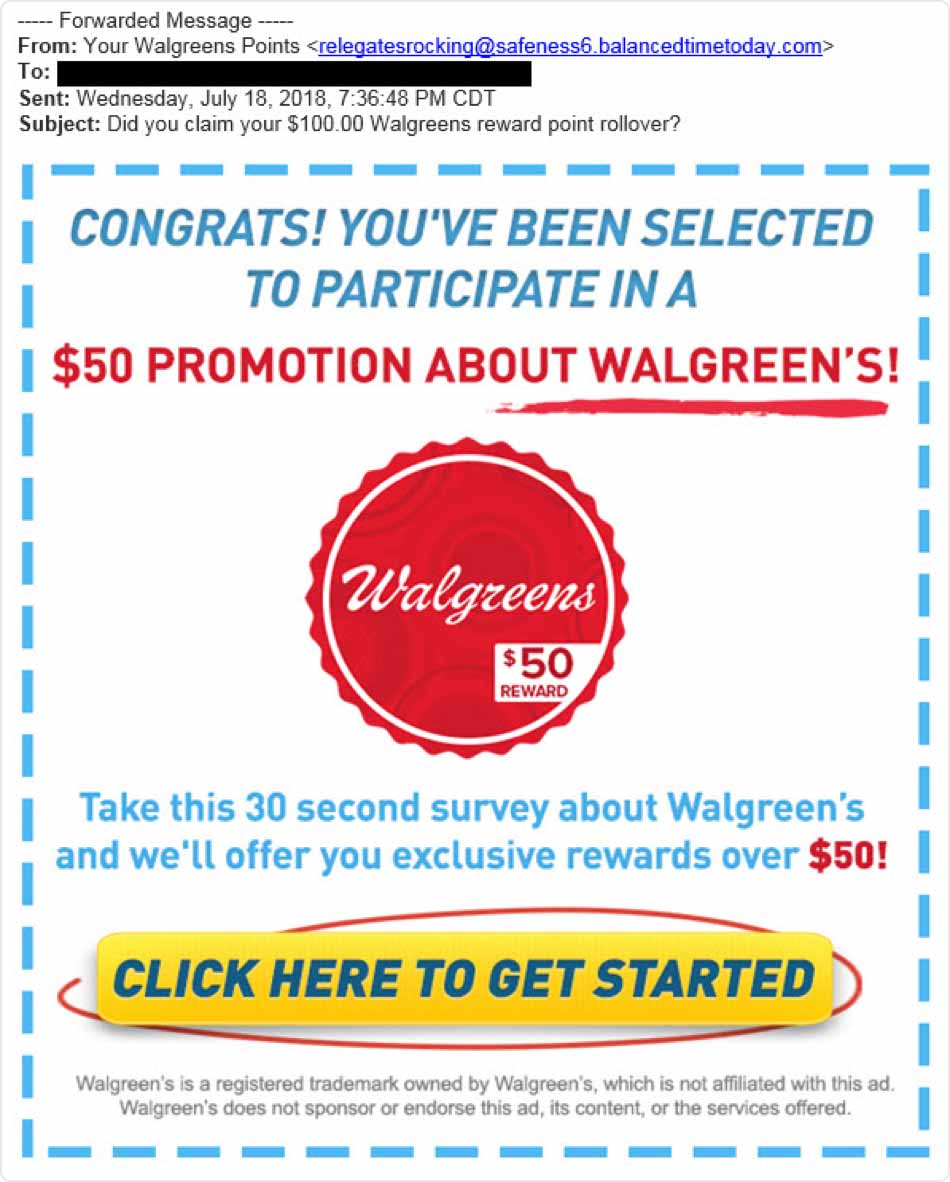
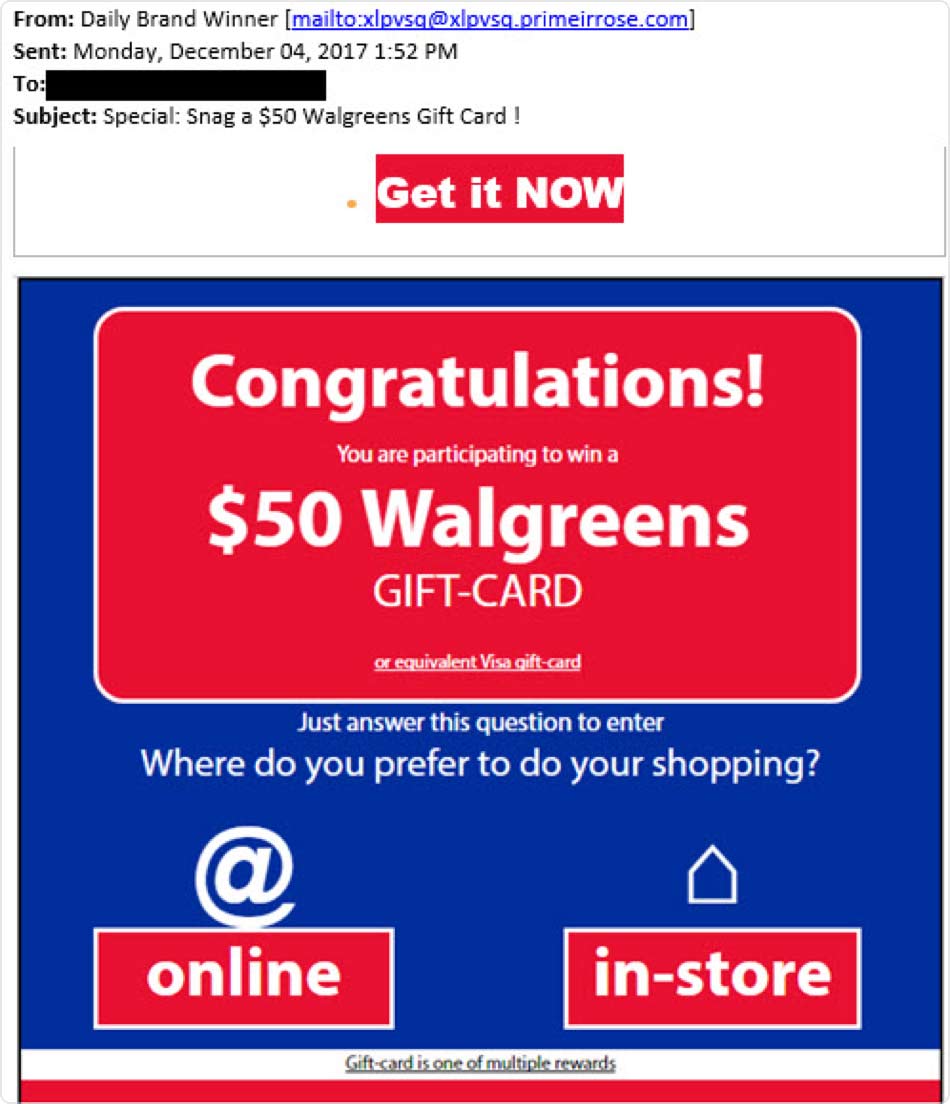
Loyalty Cash Rewards Expiring
Walgreens may inform myWalgreens loyalty members when their rewards are expiring, however the below example is not from a legitimate Walgreens email address and Walgreens will never require you to take action to claim rewards.

Order Confirmation or In-Store Purchase Receipt
You will only receive an order confirmation or purchase receipt email if you completed an order on Walgreens.com or are opted into digital receipts for in-store purchases through myWalgreens. If you did not place an order or recently make an in-store purchase and aren’t opted into digital receipts, the email is a scam; the perpetrators are expecting you to be concerned and click on a link in the email without considering its legitimacy. If you would like to see if an order was placed using your account, log in directly using the Walgreens app or on Walgreens.com.

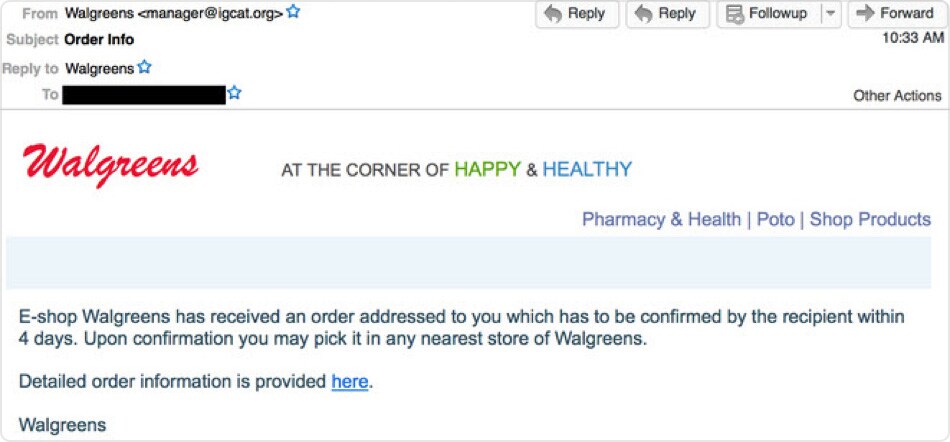
Password Reset
Password reset emails are only legitimate if you initiated the process on Walgreens.com or the Walgreens App. If you did not initiate the password reset, the email is a scam. To review a list of devices recently used to access your account, visit the Security Information page.
How to Report Phishing Emails
- To report it directly to Walgreens, forward the email to report-fraud@walgreens.com.
- To report it to the Federal Trade Commission (FTC), forward the email to spam@uce.gov or visit their website.
- To report it to the Anti-Phishing Working Group (APWG), forward the email to reportphishing@apwg.org or visit their website.
- SMS (Text Message) Phishing
Like its email-based counterpart, text message phishing (usually referred to as SMS (Short Message System) phishing or "smishing") uses social engineering tactics in an attempt to gain access to private information. It may also use Walgreens' name or logo to make it appear legitimate.
While Walgreens sends the majority of our communications through email, customers can opt-in to receive important pharmacy and order updates via text message (e.g., prescription or order status). However, we will never request personal, financial, or account information; if you receive something asking for this type of information, you can be confident it didn't come from Walgreens.
Examples of SMS Phishing
The following are examples of phishing texts purporting to be from or affiliated with Walgreens. These are NOT legitimate communications from Walgreens, and recipients should not open links, disclose personal information, or respond.
Free Gift Card or Prize
Messages of this nature claim they are offering a free prize as part of a giveaway. Walgreens does not participate in these types of promotions, and we do not contact our customers through unsolicited text message campaigns.
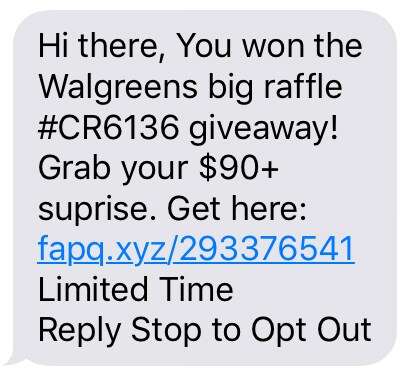


Reward for Completing a Survey
These messages are similar to the previous example, except they claim they will send a gift in exchange for completing a survey. Customer survey requests that are validly from Walgreens are offered at the bottom of an in-store purchase receipt or sent via email to customers who make a Ship to Store or Walgreens.com order.

Order Confirmation
If you place an order on Walgreens.com, an order confirmation and receipt will be only be sent to you electronically via email and never in a text. If you receive this type of message, you shouldn't open any links or respond and delete it immediately. The perpetrators are expecting you to be concerned and click on a link without considering its legitimacy.
If you would like to see if an order was placed using your account, sign in directly using the Walgreens App or go to Walgreens.com.

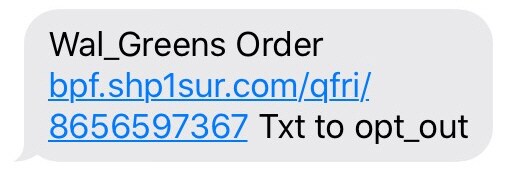
- Mystery Shopping Scams
A mystery shopper is an individual hired to evaluate the customer experience of a business by posing as a regular shopper. While legitimate mystery shopping opportunities exist, Walgreens does not utilize these types of programs for our business. If an offer to be a mystery shopper at Walgreens is received, please be advised this is not a legitimate job opportunity and likely a scam.
In this type of scam, unsolicited emails advertising a mystery shopping position are sent with a link to fill out an application. Once the scammers have the applicant’s personal information, they then send a follow-up email letting the potential victim know they’ve been selected for the job and can expect to receive a check in the mail within a week or two.
The scammers claim the check is to cover both purchases at the store while mystery shopping and payment for the job. They instruct the victim to go to the store and buy gift cards and send them images of the gift cards with the PIN scratched off. Once the scammers receive the gift card information, they cut communication with the victim. Within a few days, the bank notifies the victim that the check is fake and, since most or all the check funds have been spent, they are responsible for paying the bank back for the check.
If you receive an email or text message offering a mystery shopping position with Walgreens, avoid responding or clicking embedded links and immediately delete it.
Examples of Mystery Shopper Scam Emails
The following are examples of scam emails advertising fake mystery shopping positions with Walgreens. These are not legitimate job offers.
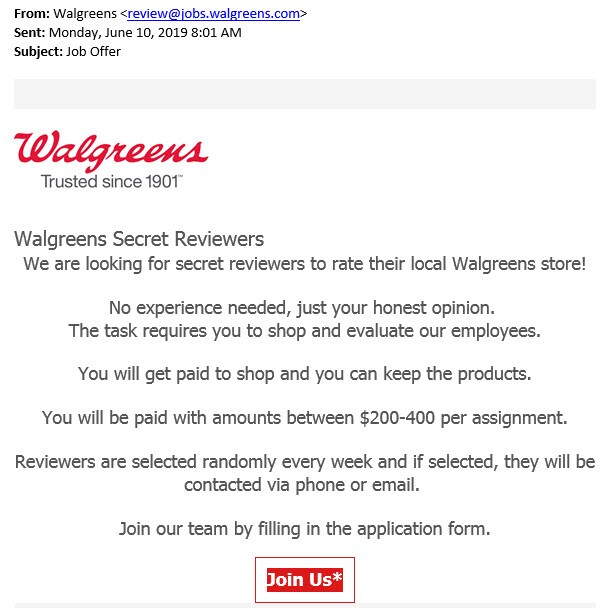
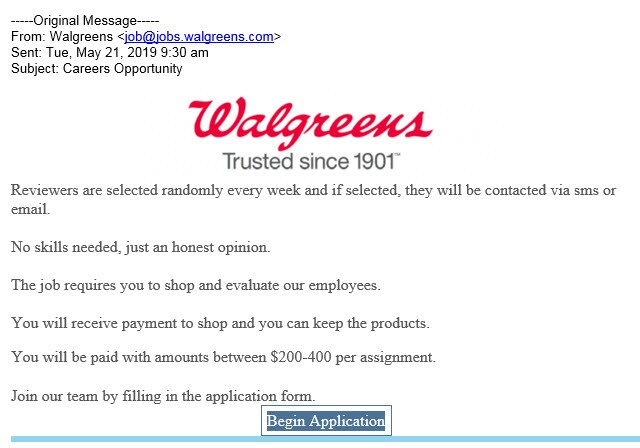


- Employment & Recruitment Scams
Scammers are increasingly targeting job seekers to gain access to a victim's personal information or deceive them into sending money. Oftentimes they will pose as a representative from a real company, like Walgreens, to appear more legitimate and may even impersonate an actual employee, such as an executive from Human Resources. That way, if a potential victim conducts an online search of the individual they believe they're communicating with, they will be able to confirm a person with that name works at the company and be more likely to comply with what the scammer is asking them to do.
Scams of this nature have been reported where potential victims receive checks from scammers for the alleged purpose of training or equipment expenses but are later identified as counterfeit by the bank. Once the check is deposited and the funds are available, the scammer may claim the amount of the check was an overpayment and request the victim send some of the funds back. Because banks are legally required to make deposited check funds available within days and identifying a fake check can take several weeks, the funds are usually spent by the time the check is confirmed counterfeit and the victim is responsible for paying the bank back for the full amount.
Please be aware of suspicious recruitment or employment opportunities using these and similar types of tactics. Additional reports involve scammers creating fictitious Walgreens email addresses and conducting interviews via social media or instant messaging services (e.g., Yahoo Messenger, Google Hangouts). Walgreens does not use these services for the hiring process, nor do we solicit payment for job applications, training expenses, or equipment.
If you are concerned that recruitment activity or an offer of employment with Walgreens might be a scam, please verify by searching for the posting on our Careers website or email corporate.careers@walgreens.com to report the incident.
Employment & Recruitment Scam Red Flags
- Job positing is for a generic position (e.g., administrative assistant) and the description is vague.
- Payment for employment is given prior to work being completed.
- You are not asked to complete an I-9 form or other pre-employment paperwork when hired for the position. Federal law requires U.S. employers to have this completed for every individual they recruit, refer for a fee, or hire for employment in the United States and legitimate companies will not proceed with the hiring process without this being done.
- Caller ID Spoofing
Caller ID spoofing is the act of changing the phone number and/or name of a caller displayed on the recipient's caller ID. The Federal Communications Commission (FCC) prohibits the use of this practice with the intent to defraud, cause harm, or wrongfully obtain anything of value. To make a scam more convincing, fraudsters may spoof a Walgreens phone number so it appears the call is coming from a legitimate business. Walgreens is not affiliated with this type of activity.
If you are contacted by a spoofed number:
- File a complaint with the FCC over the phone (1-888-225-5322) or online.
- File a report with your local police department.
- To report it to the Anti-Phishing Working Group (APWG), forward the email to reportphishing@apwg.org or visit their website.
- If financial information was given, immediately contact your bank.
- Medical Record Request Scams
Medical Record Request Scam Red Flags
These scams involve doctors’ offices receiving fraudulent faxes or letters claiming to be from Walgreens’ Medical Records Department requesting patient medical records to keep their file up to date. Requests may claim to be from someone purporting to be the Manager of the Records Department and include both a phone number and fax number to send the requested information to. To appear more legitimate, these communications may use Walgreens’ name or logo and other trade organizations, such as the National Association of Boards of Pharmacy (NABP). Walgreens is not affiliated with this type of activity.
Although Walgreens may contact providers for patient information to fulfill certain Medicare Part B billings, these requests will ask for specific items that should be known based on the items they are being billed for and will not be vague. Any requests legitimately from Walgreens will contain complete and accurate information, look aesthetically accurate, and have correct punctuation and grammar. If you are a provider that is concerned a request for a patient’s medical information may be a scam, please call 1-877-378-9787 (Monday – Friday, 8 AM – 4:30 PM CST) for verification.
- Generic or vague requests without stating specific information needed or the purpose of the request.
- Uneven or misaligned logos and text.
- Other retailer or organization logos with the Walgreens logo.
- Scanned signature for individuals claiming to be from Walgreens’ Records Department.
- Designates a pharmacy not used by the patient.
- Incorrect patient information or misspellings.
Examples of Medical Record Request Scams

- Additional Resources
Federal Trade Commission (FTC)
Internal Revenue Service (IRS)
Better Business Bureau (BBB)
FBI Internet Crime Complaint Center (IC3)
